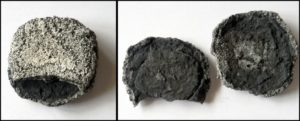Recently a visitor to our website sent us a mysterious photograph of what he called a “1715 Cookie”.
At first sight it was not clear what this object was. Our visitor indicated that there was a coin inside. He was right! Closer examination confirmed that there was a (very corroded) coin at the center of this “cookie”. The center of this “cookie” was a Potosi 8 reales.
1715 Fleet Society member Ernie Richards explained: “I have seen scads of these “cookies”… mostly from the 1733 Fleet. What I believe happens is that silver, in the presence of a source of sulfur (close proximity to decaying wood, paper, silt, other), doesn’t “oxidize” as such but rather “sulfides”. Silver sulfide is likely the corrosion process that we witness. The sulfided outer coating of the coin eventually gains the appearance of an “Oreo” cookie, with the parent silver… most time…disappearing in the ongoing chemical reaction. The sulfide coating, being as porous as it is, can permit the activity until all silver has been reduced to the sulfide product. We often cracked these open to find slivers of silver remaining, which, when cleaned, are so thin we called them “razor blades”. –ER
Special thanks to Paul Stellato from Collegeville, Pa. He graciously provided background information and pictures for our use.
DATELINE: West Palm Beach, Florida

- Posted in Newsletter
Craig Grella
Craig Grella is a digital marketer who has designed and developed more than 400 websites for businesses, nonprofits, and governments.
He has an engineering degree from Lehigh University.
He also enjoys watching Yankees baseball, playing guitar, and riding motorcycles, though not at the same time - that would be dangerous.
All Posts
